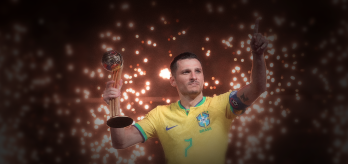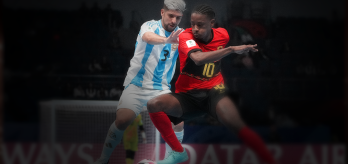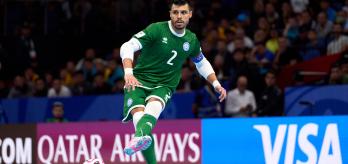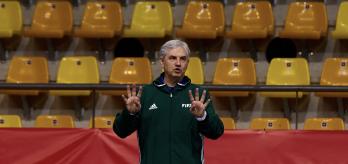One of the strongest players in 1v1 situations is Brazil winger, Dyego. The 35-year-old is a mainstay for his national team and was instrumental to their success at FIFA Futsal World Cup 2024™, where he scored four goals and claimed the adidas Golden Ball award for being the tournament’s best player. The following article unpacks the attacking potency of the Brazil and FC Barcelona star and explores how Dyego exploits 1v1 situations in the final 12 metres of the court. To begin, Dyego’s 1v1s are broken down into phases to reveal the key features allowing the winger to thrive in these situations.
Exploiting the 1v1
A compilation of Dyego’s 1v1 situations suggests his and his team’s almost systematic use of his technical abilities. Each 1v1 he engages follows an identical process, outlined in phases 1 to 5 above. His direction to bypass his opposition defender is the only aspect distinguishing one 1v1 from the next. Considering the predictability, one key question arises: why can’t defenders stop Dyego if they know what he will do? Like other world-class players with trademark skills, the difficulty in obstructing his predictable actions comes down to the perfection of his technical execution. Below is an up-close video demonstrating the speed and accuracy with which Dyego executes his actions during the 1v1.
Attacking outside
When facing an inverted winger, defending teams often try to force the attacker onto their weaker foot and toward the sideline. Dyego’s team-mates quickly recognise these situations and will often vacate his side of the court to create space for him to take the defender on in a 1v1. In these isolated situations, Dyego’s timing, disguise and explosive acceleration make his moves difficult to anticipate.
Attacking inside
With the defender either not choosing or unable to force the attacker wide, when isolated 1v1, the option for inverted wingers to drive inside onto their strong foot for a shot on goal is particularly dangerous. Dyego’s ability to jolt inside, create a new shooting angle and unleash a strike on goal can be devastating.
Excursus: How to defend when isolated 1v1
Defending against a player with 1v1 talent as devastating as Dyego’s involves several key considerations:
-
Apply immediate pressure: close down the attacker quickly, as the ball travels, to avoid the attacker engaging in a 1v1 and to force them to protect the ball. Avoid being eliminated by the attacker’s first touch if getting too close.
-
Adopt the basic defensive position: keep knees bent and positioned on the toes of the feet to be able to react quickly when the attacker makes their move. Make use of the body and arms to unbalance attacker in their line of movement.
-
Time your tackle: be patient to choose the right moment to steal the ball such as when the ball is far from the attacker’s foot or when the attacker is orientated towards their own goal or the sideline.
-
Provide cover: defenders on the opposite side of the court from the ball can help protect the centre but must make sure not to over-commit and leave attackers in space to receive and shoot. The goalkeeper can protect the first post when an attacker attacks the outside, preventing a defender from having to leave their marker and potentially giving the attacking team a numerical advantage.
The video below showcases multiple instances where defenders come out on top when isolated 1v1 against Dyego by applying the defensive principles outlined above.













